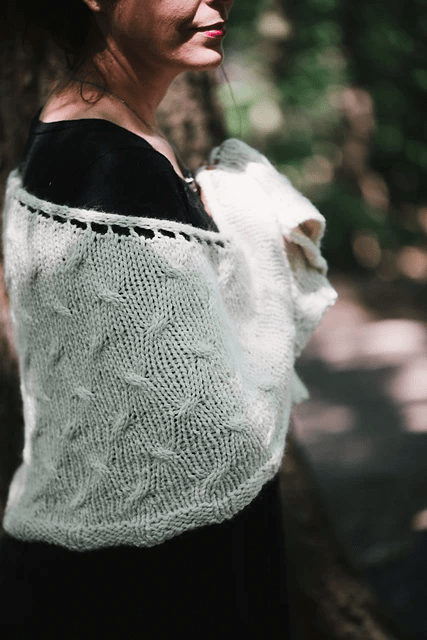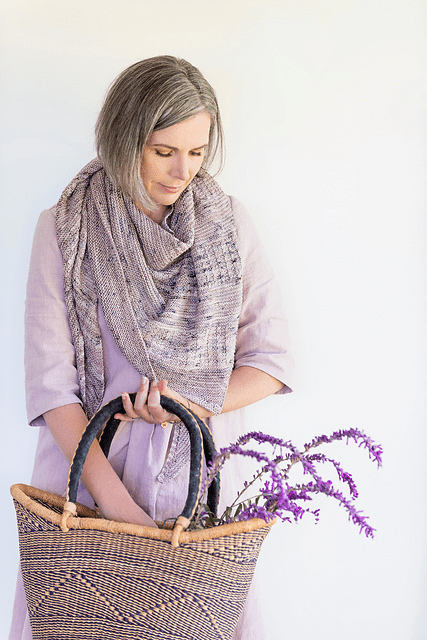
easy knitted shawl patterns for beginners

Yes, gorgeous, easy knitted shawl patterns exist.
And yes, you can make one.
If you know how to make a knit stitch, you know enough to get started.
You can learn everything else you need to know along the way. I’ll help.
Is a shawl a good knitting project for a new knitter?
Beginner knitters are often advised to start with a plain scarf, but I think all that back-and-forth can be a little boring, and a long scarf is a project that seems to go on forever. A lot of new knitters give up before finishing, which is a shame.
Starting with an easy shawl pattern is a lot more interesting and satisfying. And you’ll usually have a finished object to wear much faster than you would with a scarf, especially if you use a thicker yarn.
Choosing an easy knitted shawl pattern: what to look for

There’s a knack to designing a shawl pattern that looks impressive without being complicated or hard to make. It’s one of my specialties: I’m always asking myself, “how can I make this as simple, fun and easy to knit as possible?”
Of course, “easy” is a relative term! But with a little patience, determination, and support, you’ll be amazed at the shawls you can knit.
There are several factors that help determine where a shawl falls on the easy <———-> difficult spectrum.
Here are some things to consider when you’re trying to find an easy shawl pattern to knit:
Yarn weight
Yarn comes in many different weights, or thicknesses, and your knitting pattern will almost always recommend a specific weight.
Yarn weight is more about speed and size than difficulty, but if you’re new (or just love the idea of nearly-instant knitting gratification) heavier weight (aka thicker) yarns make for faster projects. Thick yarn takes up more space, which means you need less stitches for the same sized shawl.
Patterns that call for bulky, super-bulky, and chunky yarn will knit up super fast.

If speed isn’t of the essence, feel free to choose a pattern that uses a lighter weight yarn. Worsted, Aran, DK and Sport weight yarns all make wonderful shawls. In fact, my favourite yarn weight to design in is “fingering weight”, also known as 4 ply or sock yarn, which is quite a light/thin yarn. I think it makes wonderfully delicate, all-season shawls, while still being easy to work with.
Fingering weight is probably as light as I’d go for a beginner shawl pattern. Laceweight and cobweb yarns can be a bit tricky for new knitters: they’re so light and thin that it can be hard to keep track of your stitches.

Size
Again, this one is more about speed from cast-on to cast-off than difficulty. You can find lots of big easy shawl knitting patterns and small difficult shawl knitting patterns! But a larger shawl, especially if you’re using a thinner yarn, is a bigger commitment, and a smaller one is often the best choice for an early project.
I’m a big fan of the small “shawlette” style. It’s versatile, fashionable, cosy and fun to wear. Best of all, you can often get a whole shawl out of a single skein of yarn. That’s great news, especially for beginning knitters who might not want to invest in a whole bunch of skeins right at the start.

Stitch and technique complexity
This is where we really start to see the difference between “easy” knitted shawl patterns and “hard” ones.
The number and type of stitches and techniques used in a pattern will have a big impact on how easy it is to knit.
To knit the most basic of all shawls, you’ll need:
- A way to cast on
- A knit stitch
- A way to increase (make more stitches/make it wider) and/or
- A way to decrease (make less stitches/make it narrower)
- A way to cast off
It’s incredible what you can create with some very basic techniques. Add a purl stitch and a yarn over to this list, and there are hundreds if not thousands of shawl patterns you’ll be able to knit.
With the exception of the basic knit and purl stitches, there are many ways to do each of those things. Some are simple, some are more complex.
I do want to pause here to make an important point:
There’s a difference between “difficult” and “new.”
While there are a handful of special stitches and techniques that are intrinsically complicated or difficult to learn, most just require a little bit of practice. And now, with countless YouTube videos demonstrating every stitch and technique under the sun, if you come across something you’ve never done before, you can learn it on the spot. (Pro tip: I love slowing YouTube videos way, way down to watch a new stitch being done. About 50% speed will do wonders.)
So don’t limit yourself to plain knitting, thinking that’s the only thing a beginner can handle. With a bit of help and practice, you can do anything. Knitted shawls with simple lace, cables, all those “fancy” things are well within your reach, even as a new knitter.

Pattern writing style
This is another factor that makes a huge, huge difference in how easy a shawl pattern is to knit.
It can be the hardest one to judge, as you generally don’t get to look at how a pattern is written until you’ve bought it. But there are a few things you can look out for.
Of course, you can buy a physical pattern book at your local yarn shop or book store: it can be reassuring to have the chance to look inside and see how the patterns are laid out and how much instruction is included.
But here we are online, where the variety and choice of patterns seems infinite. So how can you tell which patterns are written clearly enough for beginners?
When buying a digital PDF pattern on Ravelry, Etsy, Gumroad or anywhere else, check the pattern description to see what they say about how it’s written. At the very least, should tell you whether the pattern includes written instructions and/or charts for stitch patterns or lace. If it uses an unusual technique, it might also let you know if there are tutorials or videos to supplement the pattern.
All of my patterns are written in the Curious Handmade Percentage Checklist™ style. This row-by-row format is super easy to follow, with stitch counts for every row and yarn percentage checkpoints at important milestones along the way. I created this format so you’ll never lose your place and never have to worry about whether or not you’ll run out of yarn. You can just enjoy the knitting and learn new techniques in a relaxed state of mind.
If you’re ready to try making your own knitted shawl, I’ve got a free pattern that’s perfect for getting started: The Spindrift Shawl.

a Free Pattern and Virtual Workshop
on making knitted shawls

Even if you’ve never knit a shawl before, this workshop is designed to encourage and motivate you all the way to the end of your first project. Get a free copy of the Spindrift Shawl pattern and a series of friendly, informative email lessons where you’ll learn:
- How to choose the right yarn and needles for your shawl
- What gauge means and whether it matters
- How to modify your shawl pattern or change the size
- How to stay on track with the clever Percentage Checklist™
- The best way to cast on
- Stitches you’ll use in the shawl
- The magic of blocking your handknit shawl
The combination of a free, easy knitted shawl pattern and step-by-step guidance over email is a fun, gentle introduction to an amazing hobby.
Become a part of the Curious Crew and
learn to make knitted shawls for free!
Thank you!
You have successfully joined our subscriber list.